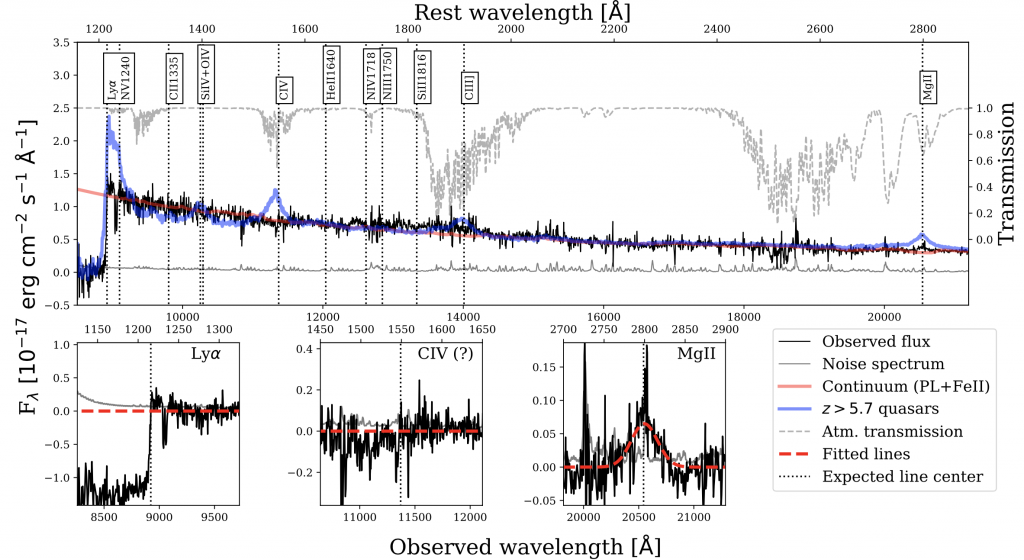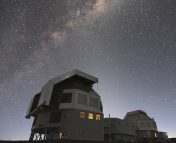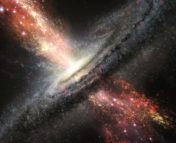Authors: Taufik Andika, Irham; Jahnke, Knud; Onoue, Masafusa et al.
First Author’s Institution: Max-Planck-Institut fur Astronomie, Germany; International Max Planck Research School for Astronomy & Cosmic Physics at the University of Heidelberg
Status: Accepted by ApJ. Open access on
Arxiv.
Old, but not that old; young, but not that bold
As the oldest object, the Universe is 13.8 billion years old. Figure 1 briefly demonstrates the expansion of the Universe, starting from the Big Bang. At the age of 400 thousand years old, the Universe gave birth to the first star and the first galaxy, which ignited the darkness. From there, the Epoch of Reionization (EoR, noted in yellow) begins, as light starts to ionize the neutral hydrogen. This reionization process takes about 1 billion years and ends at redshift (z) around 5.5. After the EoR, the Universe is fully ionized and forms the way we see it today and the place we live in now.
The mysterious EoR leaves behind its products only at very high redshift (z > 6), including quasars, a type of active galactic nuclei (AGNs) containing extremely powerful supermassive black holes. If we consider the EoR as the “good old days”, then those high redshift quasars are among the oldest citizens of the Universe. Their luminous light contains the valuable history of the long-lost era we will never see again.
However, in today’s paper, the authors found a special quasar. At z = 6.3, as far back as just ~1 billion years after the Big Bang, this quasar only has a lifetime of only a few thousand years. More interestingly, unlike the youth of humans with boldness in heart, this young quasar is very weak in the context of emissions. It has very few and weak broad lines. This particular type of quasar is called the weak emission line quasar (WLQ). From the observations of this WLQ at such a high redshift, we can take a peek at the late stage of the EoR.
Finding a needle in a haystack
Up till now, astronomers have discovered ~270 quasars at high redshift. Among these, 20 are WLQs. Although WLQs are outliers given their unusually weak emissions, they make up about ~10% of the quasar population at high redshift, which definitely should not be ignored.
Finding these abnormal objects is challenging. Normally, astronomers prefer a clear detection with a high signal-to-noise ratio (SNR). However, low SNR is necessary here to identify “weak” emissions due to the symbolic characteristics of WLQs, which may introduce lots of noise and contaminations in the data.
The authors start from over 17 million sources with redshift between 6.3 and 7.1 in Pan-STARRS1 catalog. After cross-matching with many multiwavelength surveys, the authors select 155 candidates to conduct spectroscopic observations on 6.5m-Magellan telescope, in order to confirm the nature of these candidates. This is when PSO J083.8371+11.8482 (hereafter PSO J083+11) revealed itself to the authors.
The authors took only 5 minutes to identify this literally one-in-17-million source as a WLQ, but spent hours to obtain a high-quality spectrum due to the long distance and weak emissions. Finally, the authors are able to obtain the spectrum of PSO J083+11, as shown in Figure 2. Compared to the spectrum of a typical high redshift quasar, clearly a few broad emission lines are missing in PSO J083+11.

Where are the missing emissions?
While it may seem strange to not be able to detect broad emission lines of a quasar, in actuality, it is not uncommon if the quasar is obscured. This is because the broad lines can easily be absorbed by obscuring materials, such as gas and dust around the accretion disk. However, this is unlikely to be the case for PSO J083+11: first, because there is no clear evidence that suggests shielding gas in PSO J083+11, second, because the shape of its spectrum agrees significantly with unobscured quasars.
To explore the nature of these missing emissions, the authors give us two possible explanations:
- The black hole either grows at an extraordinarily high rate, or radiates in a very inefficient way. This explanation requires a very high Eddington ratio or a massive black hole mass. However, the accretion rate and the mass derived from all the observations on PSO J083+11 don’t meet these criterions.
It is possible that deeper and more sensitive observations will improve the accuracy of these numbers. But for now, this possibility seems like a long shot.
- This quasar is too young to have a fully formed region that emits broad emission lines. This argument is supported by a popular theory of AGN evolution. Figure 3 illustrates different evolutionary stages in this theory: an AGN starts from a seed black hole (a), grows when its accretion disk is embedded completely in a dusty ball (b), then radiates away excess gas and dust (c-d), and finally dies when its fuel is consumed out (e).
Since PSO J083+11 is very young, the authors argue that it is probably at a stage between (b) and (c). The quasar has just broken out of the dusty ball and become unobscured, but hasn’t reached stage (d) to form a broad line region yet.

Given the current observation results, the authors lean more towards the second explanation. Therefore, PSO J083+11, the young WLQ at high redshift, provides support for the evolution theory of all AGNs shown in Figure 3. Undoubtedly, this “weak” quasar is, in fact, a “powerful” tool that not only documents the puzzling ending of the EoR, but also puts constraints on black hole formation models. With better instruments to be launched and more candidates to be observed, the disclosure of the secrets of the Universe is yet to come.
Astrobite edited by: Oliver Hall
Featured image credit: NASA, ESA and J. Olmsted




